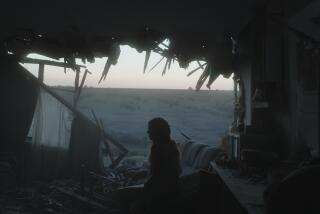‘COME AND SEE’ THE HORRORS OF WAR
- Share via
During World War II, in the Soviet Republic of Byelorussia, German soldiers burned 628 villages and slaughtered their inhabitants, exacting a terrible and unforgettable toll.
In his ambitious, grueling “Come and See” (at the Fox International) Soviet director Elim Klimov depicts this nightmarish ordeal through the eyes of Florya (Alexei Kravchenko), a sturdy peasant youth eager to join the brave partisans. By the time the Soviets have at last defeated the savage invaders, he has been transformed from a fresh-faced smiling youth into an aged man, his face transfixed by the horror and suffering he has witnessed and endured.
“Come and See,” which screened last November in the UCLA Film Archives’ Salute to the Soviet Republics, is hard to take on a second viewing because you know all the hellishness that is coming. Yet Klimov’s ability to sustain an epic stands out all the more impressively, though not flawlessly. Once Florya has left home, the film proceeds as an odyssey in several grand, elegiac--and occasionally ponderous--movements, from Florya’s shocked, sickening discovery that his family and the entire population of his village has been executed, on to his wanderings and then his confrontation with the destruction of another village in which the Germans have rounded up the citizens in a wooden town hall and set fire to it. These sequences reveal Klimov as a master of sweeping expressiveness and a creator of hallucinatory moods, in which stark, chaotic images of destruction are reinforced by an eerie, dreamlike use of sound.
With his intense passion and bravura gestures, Klimov makes a bold, stylized attempt to make “Come and See” a fresh experience instead of a story that, with variations, has been told countless times before in the Soviet cinema. To a large extent he succeeds, though not to the degree that Alexander Tarkovsky did with his similar “My Name Is Ivan.” (World War II is an enduring popular subject in the Soviet cinema and with good reason: The war was an indelible experience for the Russian people and, as a topic for film makers, it remains safe.)
Regrettably, Klimov overreaches at his conclusion, both with Kravchenko’s overly obvious makeup and by having Florya’s shooting at a portrait of Hitler trigger newsreel flashes of Der Fuehrer’s moments of public pomp and circumstance. Florya is finally stopped by the memory of that well-known photo of Hitler as a baby being held on his mother’s lap. As a result, “Come and See” (Times-rated: Mature for much graphic brutality) ends on a note both sentimental and false: How could a Byelorussian peasant boy, who most likely had never even seen a movie, have any notion of Nazi grandiosity in his imagination? Indeed, it’s impressive that he even knows what Adolf Hitler looks like.
More to Read
Only good movies
Get the Indie Focus newsletter, Mark Olsen's weekly guide to the world of cinema.
You may occasionally receive promotional content from the Los Angeles Times.









